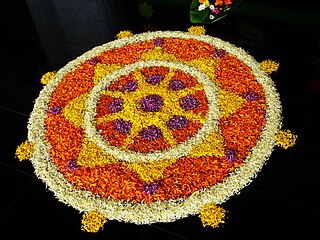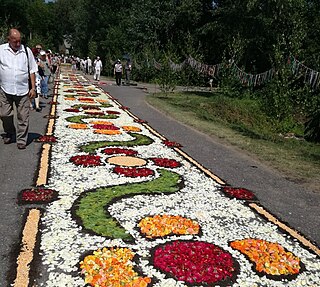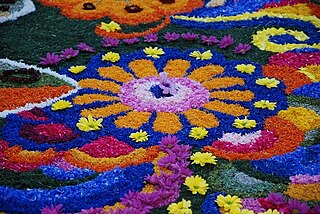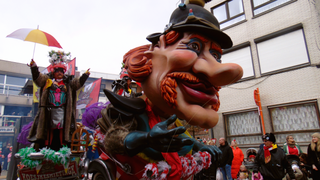
A flower carpet [lower-alpha 1] is a design made on the ground with flowers or flower petals arranged in patterns. Flower carpet events happen in many places around the world. [1]

A flower carpet [lower-alpha 1] is a design made on the ground with flowers or flower petals arranged in patterns. Flower carpet events happen in many places around the world. [1]
One of the most popular flower carpet events is the Flower Carpet biennial in Brussels in which volunteers from around Belgium convene at the Grand-Place/Grote Markt, the historic centre of the city, to weave a carpet-like tapestry out of colourful begonias or dahlias. [2] [3] The event takes place every other August, coordinating with Assumption Day, and lasts for three to four days. [4] Nearly a million flowers are required to create the ephemeral 1,800 m2 (19,000 sq ft) carpet. [5] [6]
The Guinness World Record for the largest flower carpet of the world is for Jardines of Mexico, in Teotihuacan, where an 18,000 m2 (190,000 sq ft) flower carpet was made on 8 December 2018. [7]
Carpets of live flowers are arranged for the Feast of Corpus Christi in Spycimierz, Klucz, Olszowa, Zalesie Śląskie, Zimna Wódka in Poland. The tradition was inscribed on UNESCO Representative List of the Intangible Cultural Heritage of Humanity in 2021. [8]
Flower carpets are also made on the occasion of Onam festival in Kerala, India, to welcome the legendary king, Mahabali.

The Grand-Place or Grote Markt is the central square of Brussels, Belgium. It is surrounded by opulent Baroque guildhalls of the former Guilds of Brussels and two larger edifices; the city's Flamboyant Town Hall, and the neo-Gothic King's House or Bread House building, containing the Brussels City Museum. The square measures 68 by 110 metres and is entirely paved.

Onam is an annual harvest and cultural festival related to Hinduism that is celebrated mostly by the people of Kerala. A major annual event for Keralites, it is the official festival of the state and includes a spectrum of cultural events.

The Mid-Autumn Festival, also known as the Moon Festival or Mooncake Festival, is a harvest festival celebrated in Chinese culture. It is held on the 15th day of the 8th month of the Chinese lunisolar calendar with a full moon at night, corresponding to mid-September to early October of the Gregorian calendar. On this day, the Chinese believe that the moon is at its brightest and fullest size, coinciding with harvest time in the middle of autumn.

The Feast of Corpus Christi, also known as the Solemnity of the Most Holy Body and Blood of Christ, is a liturgical solemnity celebrating the real presence of Christ in the Eucharist; the feast is observed by the Latin Church, in addition to certain Western Orthodox, Lutheran, and Anglican churches. Two months earlier, the institution of the Eucharist at the Last Supper is observed on Maundy Thursday in a sombre atmosphere leading to Good Friday. The liturgy on that day also commemorates Christ's washing of the disciples' feet, the institution of the priesthood, and the agony in the Garden of Gethsemane.

Rangoli is an art form that originates from the Indian subcontinent, in which patterns are created on the floor or a tabletop using materials such as powdered lime stone, red ochre, dry rice flour, coloured sand, quartz powder, flower petals, and coloured rocks. It is an everyday practice in many Hindu households, however making it is mostly reserved for festivals and other important celebrations as it is time-consuming. Rangolis are usually made during Diwali or Tihar, Onam, Pongal, and other Hindu festivals in the Indian subcontinent, and are most often made during Diwali. Designs are passed from one generation to the next, keeping both the art form and the tradition alive.

A medieval pageant is a form of procession traditionally associated with both secular and religious rituals, often with a narrative structure. Pageantry was an important aspect of medieval European seasonal festivals, in particular around the celebration of Corpus Christi, which began after the thirteenth century. This festival reenacted the entire history of the world, in processional performance, from Bible's Genesis to the Apocalypse, employing hundreds of performers and mobile scenic elements. Plays were performed on mobile stages, called waggons, that traveled through towns so plays could be watched consecutively. Each waggon was sponsored by a guild who wrote, designed, and acted in the plays.

A float is a decorated platform, either built on a vehicle like a truck or towed behind one, which is a component of many festive parades, such as those of Carnival in Rio de Janeiro, the Carnival in São Paulo, the Carnival of Viareggio, the Maltese Carnival, the Macy's Thanksgiving Day Parade, Mardi Gras in New Orleans, the Gasparilla Pirate Festival, the 500 Festival Parade in Indianapolis, the United States Presidential Inaugural Parade, and the Tournament of Roses Parade. For the latter event, floats are decorated entirely in flowers or other plant material.

The Barranquilla Carnival is one of Colombia's most important folkloric celebrations, and one of the biggest carnivals in the world. The carnival has traditions that date back to the 19th century. Four days before Lent, Barranquilla decks itself out to receive national and foreign tourists to join together with the city's inhabitants to enjoy four days of intense festivities. During the carnival, Barranquilla's normal activities are put aside as the city gets busy with street dances, musical and masquerade parades. The Carnival Of Barranquilla includes dances such as the Spanish paleo, African Congo, and indigenous mice y mica's. Many styles of Colombian music are also performed, most prominently cumbia, and instruments include drums and wind ensembles. The Carnival of Barranquilla was proclaimed a Cultural Masterpiece of the Nation by Colombia's National Congress in 2002. Also the UNESCO, in Paris on November 7, 2003, declared it one of the Masterpieces of the Oral and Intangible Heritage of Humanity, and it was during Olga Lucia Rodriguez Carnival Queen year.

The Savonnerie manufactory was the most prestigious European manufactory of knotted-pile carpets, enjoying its greatest period c. 1650–1685; the cachet of its name is casually applied to many knotted-pile carpets made at other centers. The manufactory had its immediate origins in a carpet manufactory established in a former soap factory on the Quai de Chaillot downstream of Paris in 1615 by Pierre DuPont, who was returning from the Levant.

Genzano di Roma is a town and comune in the Metropolitan City of Rome, in the Lazio region of central Italy. It is one of the Castelli Romani, at a distance of 29 kilometres (18 mi) from Rome, in the Alban Hills.

Puli kali is a recreational folk art from the state of Kerala, India. It is performed by trained artists to entertain people on the occasion of Onam, an annual harvest festival, celebrated mainly in the Indian state of Kerala. On the fourth day of Onam celebrations, performers painted like tigers and leopards in bright yellow, red, and black shake their bellies and dance to the beats of instruments like Udukku and Thakil. The literal meaning of Pulikkali is 'The tiger dance' hence the performance revolves around the theme of tiger hunting. Folk art is mainly practiced in the Thrissur district of Kerala. The best place to watch the show is at Thrissur on the fourth day of Onam, where Pulikkali troupes from all over the district assemble to display their skills. The festival attracts thousands of people to the Thrissur city. Pulikkali is also performed during various other festive seasons.

Gmina Uniejów is an urban-rural gmina in Poddębice County, Łódź Voivodeship, in central Poland. Its administrative centre and the seat of the local government is the town of Uniejów, which lies approximately 14 kilometres (9 mi) north-west of Poddębice and 51 km (32 mi) north-west of the regional capital Łódź.

A Turkmen rug is a type of handmade floor-covering textile traditionally originating in Central Asia. It is useful to distinguish between the original Turkmen tribal rugs and the rugs produced in large numbers for export mainly in Pakistan and Iran today. The original Turkmen rugs were produced by the Turkmen tribes who are the main ethnic group in Turkmenistan and are also found in Afghanistan and Iran. They are used for various purposes, including tent rugs, door hangings and bags of various sizes.

Thiruvathira or Thiruvathirai or Arudhra Darisanam is a Hindu festival celebrated in the Indian states of Kerala and Tamil Nadu. Thiruvathirai (Arudhra) in Tamil means "sacred big wave". In Chidambaram in Tamil Nadu, the Nataraja Temple's annual festival is celebrated on this date. In the month of Makaram Thiruvathira Star is celebrated in Mathira Peedika Devi Temple, owned by Thiruvithamcore Devaswom Board, near Kadakkal in Kollam District of Kerala state.

Bloemencorso Zundert is the largest flower parade in the world. The parade takes place on the first Sunday of September, in Zundert, Netherlands. The floats are large artworks made of steel wire, cardboard, papier-mâché, and flowers. They are constructed entirely by volunteers. In the Bloemencorso Zundert, only dahlias are used to decorate the floats. Thousands often required to construct one and in total, around 8 million dahlias are needed for the Corso. Of these, around 6 million are cultivated in Zundert. The parade was founded in 1936.

Traditions of Italy are sets of traditions, beliefs, values, and customs that belongs within the culture of Italian people. These traditions have influenced life in Italy for centuries, and are still practiced in modern times. Italian traditions are directly connected to Italy's ancestors, which says even more about Italian history.

Sawdust carpets are one or more layers of colored sawdust, and sometimes other additional materials, laid on the ground as decoration. Sawdust carpets are traditionally created to greet a religious procession that walks over them. The tradition of decorating streets in this fashion began in Europe and was brought to the Americas by the Spanish. The tradition is still found in Mexico, Central America, parts of South America and parts of the United States, but it is strongest in Mexico and Central America.

Infiorate di Spello is a manifestation which takes place every year in the small Umbrian town of Spello (Italy) on the Feast of Corpus Christi. On that night, almost a thousand people work incessantly to create carpets and pictures made of flowers along the town's narrow streets. Floral creations cover streets throughout the historical centre in preparation for the passage of the Blessed Sacrament carried in procession by the bishop on Sunday morning. The result is a unique, one mile-long path of beautiful floral creations with an explosion of colors and scents.

The Carnival of Aalst is an annual three-day event in Aalst, East Flanders, Belgium. The carnival is celebrated in the days preceding Ash Wednesday. It is mainly a street happening; the celebrants dance on the town squares and visit café after café.

The Flower Carpet is a biennial event in Brussels in which volunteers from around Belgium convene at the Grand-Place/Grote Markt, the historic centre of the city, to weave a carpet-like tapestry out of colourful begonias or dahlias. The event takes place every other August, coordinating with Assumption Day, and lasts for three to four days. Nearly a million flowers are required to create the ephemeral 1,800 m2 (19,000 sq ft) carpet.